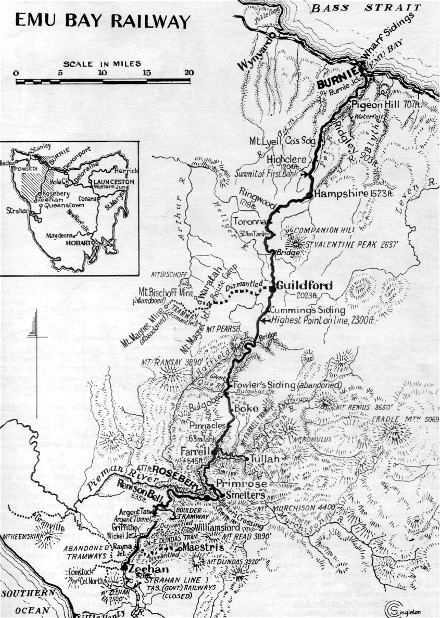 | ||
The history of the Railways on the West Coast of Tasmania has fascinated enthusiasts from around the world, because of the combination of the harsh terrain in which the railways were created, and the unique nature of most of the lines.
Contents
- Railways tramways and haulages
- Proposed but not constructed
- West Coast Railways Timeline
- Dispersal of Rolling Stock
- References
The Mount Lyell rack railway which has an Abt rack system, the presence of the world's first Garratt locomotive and a Hagans articulated locomotive on the North East Dundas Tramway, and the collection of narrow-gauge lines as the only links to the outside world for a number of the communities for over fifty years.
The haulage railways at Mount Read, and the various ones in the area of the Mount Lyell mining lease - were also significant in their use in moving both people and metal ore. Also aerial ropeways were operating in the region well into the late twentieth century.
A number of proposed railway lines that were proposed in the late nineteenth century, and early twentieth century - but never appeared - not all proposed lines are listed here.
The main mining towns during their boom times were connected with the outside world by railway as the main form of transport into their communities and also out to the outside world.
Railways, tramways and haulages
Most lines were 3 ft 6 in (1,067 mm) 2 ft (610 mm) track gauges.
See also Zeehan for tramways that centred on that locationThe following list is of most of the significant named lines but it is not a complete list. There have also been haulage lines, and other tramlines within small areas that existed in mining leases and forest areas.
Proposed but not constructed
West Coast Railways Timeline
Dispersal of Rolling Stock
Following closing of various lines, engines and carriages were often re-located on other working railways. Ex Mount Lyell passenger stock can be found on the Puffing Billy Railway in Victoria, while by serendipity the West Coast Wilderness Railway has seen the return of reconditioned engines that used to work on the original Mount Lyell lines. A number of steam engines are held at the West Coast Pioneers Museum in Zeehan.
Following the closures of most railways in the early 1960s, rolling stock was dispersed but engines were fortuitously retained on the west coast, in most cases at the museum in Zeehan. Some of these have returned to service on the West Coast Wilderness Railway.
